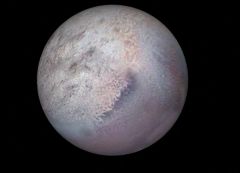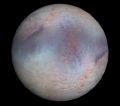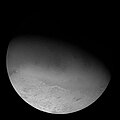Difference between revisions of "Triton"
(Added infobox, tables, content.) |
(Added category.) |
||
| Line 67: | Line 67: | ||
[[Category:Celestial bodies]] | [[Category:Celestial bodies]] | ||
[[Category:Natural satellites]] | [[Category:Natural satellites]] | ||
| + | [[Category:Satellites of Neptune]] | ||
{{Nsat-Stub}} | {{Nsat-Stub}} | ||
Revision as of 11:48, 8 August 2024
Triton is the largest moon of Neptune and the seventh largest moon in the Solar System.It the only moon of Neptune that has reached hydrostatic equilibrium and it has a thin atmosphere. Triton's orbit is retrograde.
Triton was discovered by William Lassell on 10 October 1846, just 17 days after Neptune was discovered.
Triton in Orbiter
Triton was introduced to Orbiter with the add-on uranus-neptune-moons.zip in October 2002.
| Add-on | Source | Version | Author | Type | Release Date | Compatibility | Wiki article |
|---|---|---|---|---|---|---|---|
| Uranus / Neptune Moons Addon | AVSIM | Robert Stettner (Foxtrot) | Scenery | 12 October 2002 | |||
See also
Triton as seen by Voyager 2
| Neptune's natural satellites |
|---|
| Named satellites:
Despina | Galatea | Halimede | Hippocamp | Laomedeia | Larissa | Naiad | Nereid | Neso | Proteus | Psamathe | Sao | Thalassa | Triton Numbered Satellites: |
| See also: Pronunciation key | rings of Neptune |
| edit The Solar System | |
|---|---|
| Central star |
Sun (Sol) |
| Planets |
Mercury - Venus - Earth - Mars - Jupiter - Saturn - Uranus - Neptune |
| Natural satellites |
Moon - Phobos - Deimos - Io - Europa - Ganymede - Titan - more... |
| Add-ons |
Planets - Dwarf Planets - Small objects - Natural satellites - Alternative star systems |
 | This natural satellite related article is a stub. You can help Orbiterwiki by expanding it.
|


